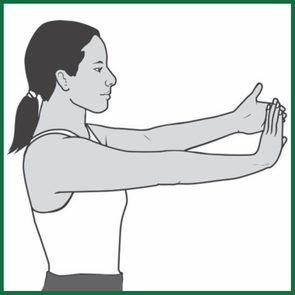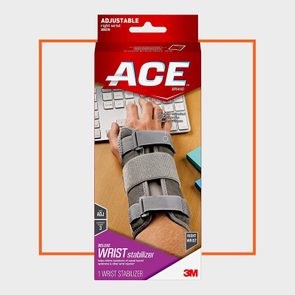5 Wrist Stretches to Help Mobility and Prevent Wrist Pain
Updated: Mar. 14, 2022
Wrist mobility is more important than you may think—learn how to prevent wrist pain by adding these stretches to your routine.
The importance of stretching your wrists
Chances are, you stretch your wrists on a semi-regular basis, even if you don’t realize it.
Maybe you do a few wrist circles after typing on your computer all day. Or perhaps you press your palms down on your desk to hyperextend your joints.
That’s a good start. But you’ll want to make a conscious effort to add wrist stretches to your daily routine.
Failing to proactively stretch and strengthen the small muscles of your forearms, wrists, and hands can contribute to injuries and pain.
(Try these carpal tunnel exercises for wrist pain.)
“Nowadays the importance of strength is popular acknowledgment, but mobility is occasionally forgotten,” says Brett Durney, a certified personal trainer and CEO and strength coach for Fitness Lab, a boutique personal training gym in London.
The wrist functions as a link between the fingers and the elbow. So any limitations of mobility at the wrist have a ripple effect that you’ll feel up and down the arm. It can potentially cause more problems and pain in other areas.
Not only that, but poor wrist mobility can affect how well you do the things you love.
“We need a good range of motion to do everything from mundane tasks to the most advanced movements in sports,” Durney says.
Without adequate wrist mobility, an athlete will struggle to complete pull-ups and push-ups. A guitarist will have trouble playing guitar. Even tasks like writing can be hard if your wrist doesn’t have proper range of motion, Durney says.
To maintain wrist flexibility and ensure you’re able to carry out your daily tasks, keep reading. These five stretches will improve your wrist strength and help you avoid aches and injuries.
(Got thumb pain? Here are the reasons why it hurts.)
Two types of wrist stretches
When thinking about stretching the wrist to maintain mobility, you need to think about how you typically use your wrist.
“Our wrists are formed of many smaller bones, ligaments, and joints that allow our hands to move in multiple directions, and these movements can be classified in two ways: closed chain and open chain,” Durney says.
- Closed-chain movement: When the hand is fixed on the ground or on bar—like during a push-up or pull-up—it doesn’t move, but the wrist can.
- Open-chain movement: If the hand isn’t fixed, both it and the wrist can move. You’re in this type of motion when writing, waving, or shooting a basketball.
You need to maintain mobility of the wrist in order to do both types of movement.
Inadequate mobility may make it hard to do both types of stretching—or just one type. You may have no problem shooting a basketball (especially if you don’t hyperextend your wrist to do so), but if you try to perform a push-up, suddenly you find that the hyperextended position feels uncomfortable or painful.
Keep in mind: when mobility at one joint is limited, it doesn’t necessarily mean you won’t be able to perform the movements that you want to perform.
What ends up happening is other muscles or joints make up for your lack of mobility. That can lead to muscle imbalances and, eventually, other injuries or pain, says Durney.
Easy stretches for the wrist
Stretching your wrists throughout the day is important to reduce tension and boost mobility in your joints.
You can easily perform most of these moves at your desk, while watching TV at home, or as part of your regular workout routine.
Open-chain wrist extension
As part of your regular stretching routine and at least a few times throughout the day, make sure you’re running through a few quick and easy wrist stretches, like this one, to bolster the mobility of this important (and sometimes ignored) joint.
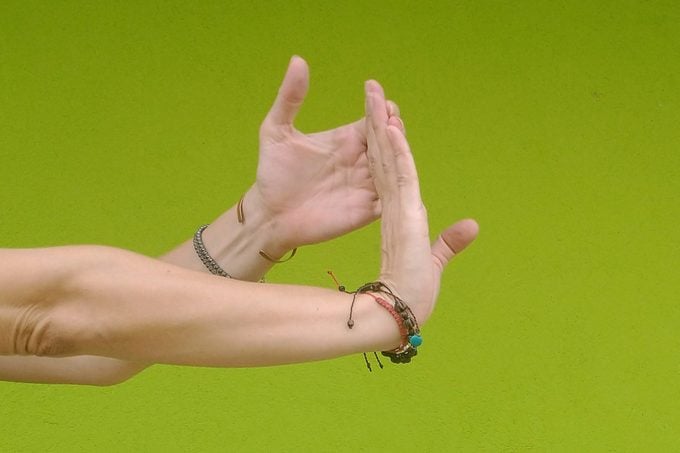
How to do it
Sit or stand with your feet planted hip distance apart, using good posture so your ears are stacked above your shoulders and hips.
Extend your right arm in front of your shoulder, pointing your fingers straight ahead with your palm facing down.
Hyperextend your right wrist as far as you can, so your fingers point toward the ceiling.
When you reach the end of your range of motion and feel a stretch, place your left fingers behind your right fingers. The left hand should help the right maintain the position and deepen the stretch, if you can.
Hold for 20 seconds, release, then repeat two more times before switching sides.
(The difference between static and dynamic stretching.)
Open-chain wrist flexion
The wrist flexion starts in the same way as the wrist extension.
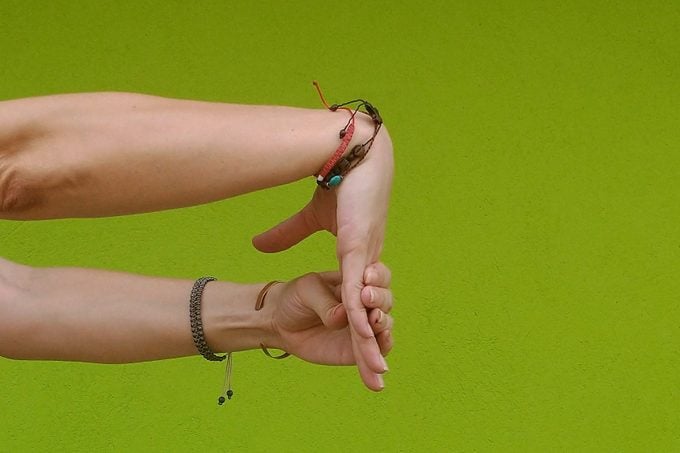
How to do it
Sit or stand with your feet planted, paying attention to using good posture.
Extend your right arm straight ahead from your shoulder, your palm facing down. Bend your wrist, flexing until your fingers point toward the floors.
When you reach the end of your range of motion and feel a slight stretch at the top of your wrist and forearm, place your left fingers behind your right fingers. Use them to help maintain the position and deepen the stretch, if you can.
Hold for 20 seconds, release, then repeat two more times before switching sides.
(Here’s how you can work to protect your joints.)
Active wrist extension
People tend to have a harder time with wrist extension than flexion, so actively moving the wrist from an extended to a hyperextended position can be helpful to work on an active range of motion.
You can do this stretch as a warm-up before any activity (like typing or swinging a baseball bat) where you’ll be extending (and hyperextending) your wrists.
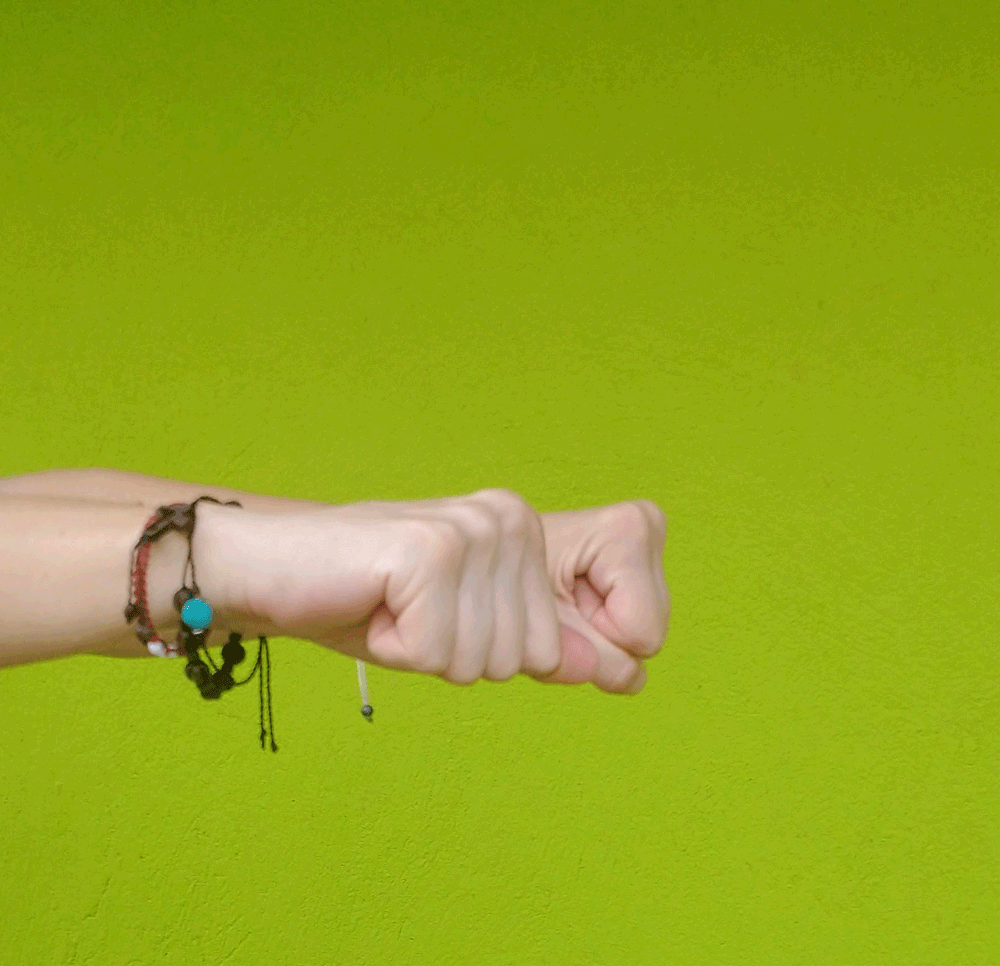
How to do it
Sit or stand with good posture, your feet planted on the floor roughly hip distance apart.
Extend both arms in front of your shoulders with your palms facing down.
Make a fist with both hands, squeezing your hand for a beat to activate the muscles of your forearms, hands, and wrists. Release the fist and hyperextend your wrist as far as you can. Reach your fingers up toward the ceiling.
Hyperextend your wrist as far as you comfortably can. When you reach the end of your range of motion, hold for a beat before reversing the movement and returning to the starting position.
Perform two sets of 20 repetitions.
(Improve your mobility with these stretches for hip pain.)
Open-chain pronation and supination
Flexion and extension aren’t the only movements your wrists perform. They also need good mobility to pronate and supinate. Those are fancy exercise terms that describe turning your thumb toward your body and away from your body, respectively.

How to do it
Sit or stand with your feet planted hip distance apart, maintaining good posture.
With your elbows bent at a 90-degree angle and fixed to your sides, position your hands perpendicular to the floor so your thumb is pointing toward the ceiling and your pinkie is pointing toward the floor.
Keeping your upper arm fixed, turn your wrists inward, so your thumb rotates as far as possible toward your body.
Hold for a beat at the end of your range of motion, then reverse the movement. This time, turn your wrists as far as you can outward, so your thumb rotates as far as possible away from your body.
Hold for a beat and continue.
Perform two sets of 20 repetitions. A single repetition includes turning the wrist toward and away from your body.
(Don’t forget to stretch your ankles too.)
Closed-chain hyperextension
An area where many people tend to have problems is with closed-chain hyperextension, where the hands are fixed to an object, like the floor.
While this may not pose major problems in day-to-day life, for those working on push-ups, or anyone who has to perform pushing movements on a regular basis, wrist pain may interfere with the ability to perform the tasks.
The key to this stretch is to do what you can, but don’t push it. You want to feel a stretch, but you don’t want to feel pain. Respect your personal range of motion.
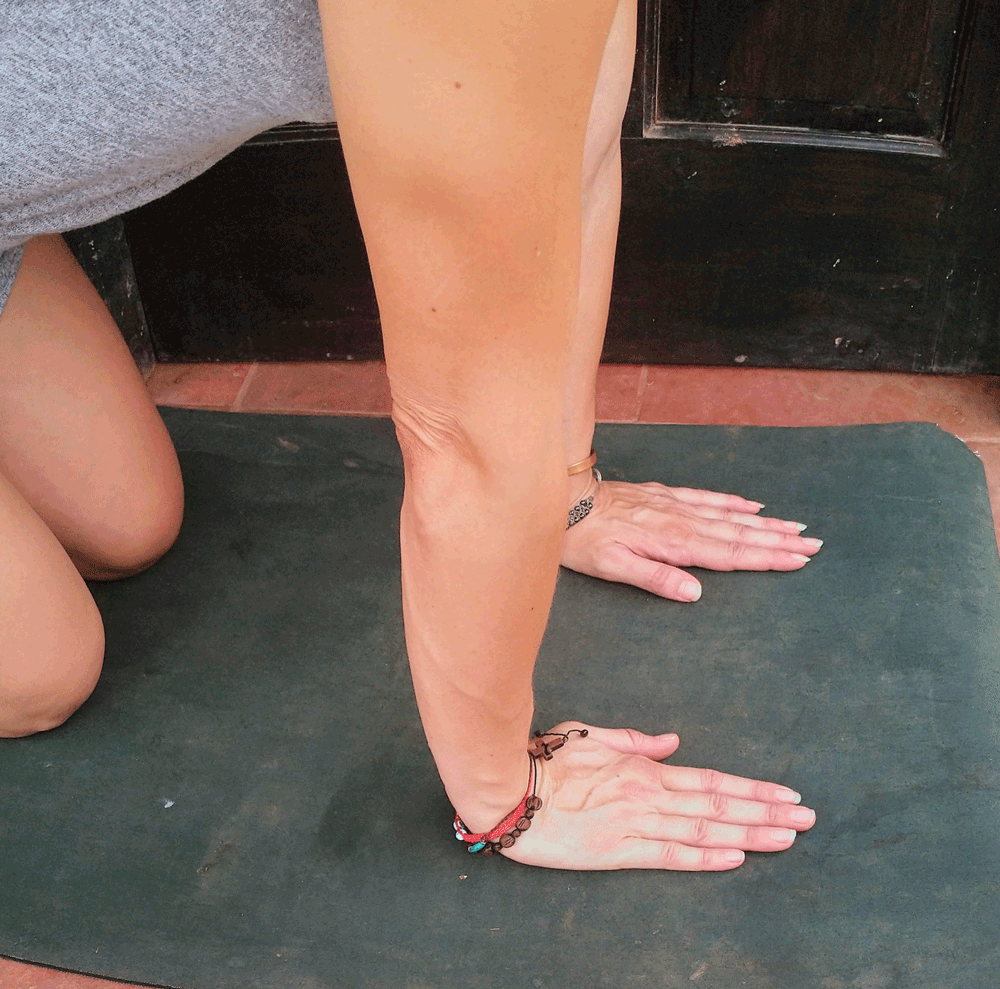
Kneel on the ground on your hands and knees. Sit back on your heels so your hands are positioned in front of your shoulders.
Your arms should be extended and your wrists slightly hyperextended—but not at a 90-degree angle.
Shift your weight forward, extending your knees slightly to move to more of a “tabletop” position. Your knees and wrists will move closer to 90-degree angles. Continue shifting your weight forward until you feel a stretch in your wrists.
You may end up shifting your shoulders to a position in front of your wrists, depending on your own flexibility. If that causes pain or is uncomfortable, don’t lean so far forward.
When you reach the end of your range of motion, hold for a beat, then return to the starting position.
Perform two sets of 20 repetitions.
Next, here’s what doctors say about taking supplements for joint pain.




















